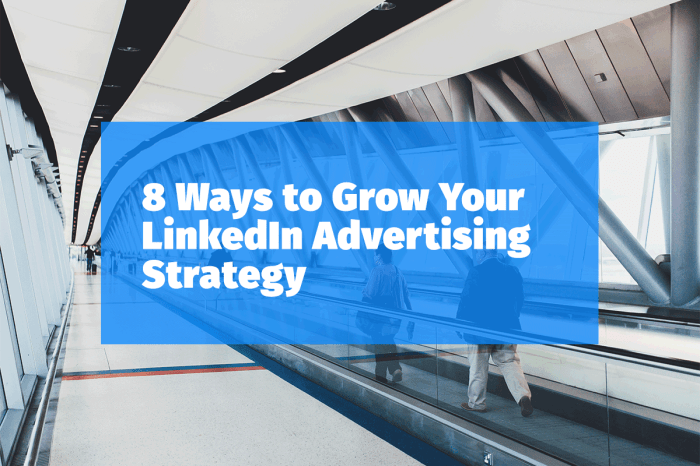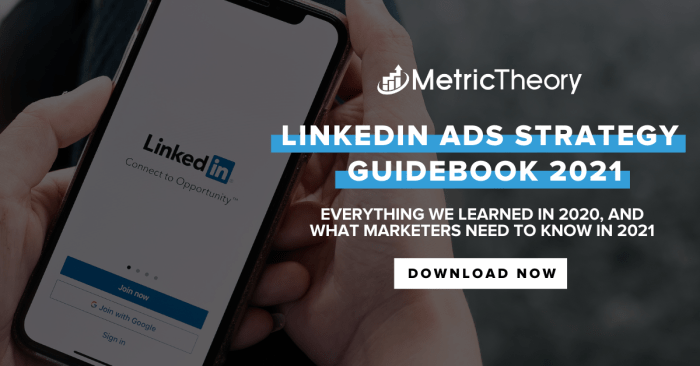Developing a LinkedIn Ads Strategy dives deep into the world of targeted advertising on the professional networking platform, offering insights and tips on how to create impactful campaigns that resonate with your audience. From setting clear objectives to crafting compelling ad creatives, this guide covers it all with a fresh and engaging perspective.
Understanding LinkedIn Ads

LinkedIn Ads are a powerful tool for businesses looking to reach a professional audience and generate leads. With over 700 million members, LinkedIn offers a unique platform for targeting specific demographics and interests.
Types of Ads on LinkedIn
- Sponsored Content: Promote your company page, share content, or drive brand awareness.
- Text Ads: Display text-based ads to specific audiences based on demographics, job titles, and more.
- Sponsored InMail: Send personalized messages directly to users’ LinkedIn inboxes.
- Dynamic Ads: Customize ads to each viewer based on their LinkedIn profile information.
Targeting Options on LinkedIn Ads
- Job Title Targeting: Reach users based on their job titles, functions, and seniority levels.
- Company Targeting: Target employees of specific companies or industries.
- Interest Targeting: Engage users based on their interests, groups, and behaviors on LinkedIn.
- Location Targeting: Reach users in specific geographic regions or countries.
Setting Objectives
Defining clear objectives for a LinkedIn Ads strategy is crucial for achieving success in your campaigns. Objectives serve as a roadmap, guiding your efforts towards specific goals and outcomes. It is essential to align these objectives with your overall marketing goals to ensure that your LinkedIn Ads efforts are contributing to the larger picture of your marketing strategy.
Importance of Aligning Objectives with Marketing Goals, Developing a LinkedIn Ads Strategy
Setting objectives that are in line with your marketing goals helps ensure that your LinkedIn Ads campaigns are working towards the same overarching mission. Whether your marketing goal is to increase brand awareness, generate leads, or drive website traffic, your LinkedIn Ads objectives should support these goals. This alignment ensures that your resources are being used effectively and efficiently to achieve the desired outcomes.
- Example 1: Increase Brand Awareness – Objective: Increase the number of impressions and engagement on LinkedIn Ads to boost brand visibility among the target audience.
- Example 2: Generate Leads – Objective: Drive conversions through LinkedIn Ads by encouraging users to sign up for a webinar or download a whitepaper.
- Example 3: Drive Website Traffic – Objective: Increase click-through rates on LinkedIn Ads to direct traffic to specific landing pages on your website.
Audience Targeting: Developing A LinkedIn Ads Strategy
Identifying and targeting the right audience on LinkedIn is crucial for the success of your ads. By reaching the right people, you can maximize the effectiveness of your campaigns and drive better results.
Creating Audience Segments for Better Targeting
When creating audience segments for better targeting on LinkedIn, consider the following tips:
- Utilize LinkedIn’s targeting options: Take advantage of LinkedIn’s demographic and professional targeting options to narrow down your audience based on factors such as job title, industry, company size, and more.
- Segment based on interests: Tailor your ads to specific interests or behaviors that align with your target audience’s preferences.
- Use retargeting: Retargeting allows you to reach users who have already engaged with your brand, increasing the likelihood of conversion.
- Experiment with lookalike audiences: Create lookalike audiences based on your existing customer data to find new prospects who share similar characteristics.
Importance of Using LinkedIn’s Demographic and Professional Targeting Options
LinkedIn’s demographic and professional targeting options provide a powerful way to hone in on your ideal audience. Here’s why they are important:
- Precision targeting: These options allow you to target users based on specific criteria, ensuring your ads are seen by the right people.
- Increased relevance: By targeting users who are more likely to be interested in your products or services, you can improve the relevance of your ads and drive higher engagement.
- Better ROI: With more targeted campaigns, you can expect to see a higher return on investment as you are reaching a more qualified audience.
Ad Creative and Copy
Creating compelling ad creative and writing effective ad copy are crucial components of a successful LinkedIn Ads strategy. Your ad creative should grab the attention of your target audience and entice them to take action, while your ad copy should clearly communicate your message and resonate with the viewers. Let’s dive into best practices and examples to help you craft winning ad creatives on LinkedIn.
Best Practices for Ad Creative
- Use high-quality visuals: Ensure your images or videos are eye-catching and relevant to your message.
- Highlight benefits: Focus on the value proposition of your product or service to attract the attention of potential customers.
- Keep it simple: Avoid cluttered designs and excessive text to maintain a clean and professional look.
- A/B test: Experiment with different creatives to see what resonates best with your audience and optimize accordingly.
Writing Effective Ad Copy
- Be concise: Keep your copy clear and to the point, highlighting the most important information.
- Use a strong call-to-action: Encourage viewers to take the desired action, whether it’s visiting your website, signing up for a demo, or making a purchase.
- Personalize when possible: Tailor your copy to speak directly to your target audience’s needs and pain points.
- Include social proof: Incorporate testimonials, case studies, or statistics to build credibility and trust with your audience.
Examples of Successful Ad Creatives
“Join thousands of satisfied customers with our premium subscription service – Upgrade now!”
“Discover the secret to boosting your ROI with our exclusive marketing toolkit – Download for free!”
“Learn from industry experts in our upcoming webinar series – Reserve your spot today!”
Budgeting and Bidding
When it comes to running successful LinkedIn Ads campaigns, setting an appropriate budget and understanding the bidding options are crucial for achieving your desired results.
Setting Budgets for LinkedIn Ads Campaigns
- Determine your overall marketing budget and allocate a specific amount for LinkedIn Ads.
- Consider the goals of your campaign and the potential return on investment (ROI) you are aiming for.
- Start with a conservative budget and adjust based on the performance of your ads.
Bidding Options on LinkedIn
- Auction Bidding: Allows you to set a maximum bid for your ads, and LinkedIn will automatically adjust your bid to help you win the auction.
- Cost-per-click (CPC) Bidding: You only pay when someone clicks on your ad, making it a good option for driving traffic to your website.
- Cost-per-impression (CPM) Bidding: You pay based on the number of impressions your ad receives, which can be a good choice if you want to increase brand visibility.
Optimizing Budgets and Bids for Maximum ROI
- Monitor the performance of your ads regularly and make adjustments to your budget and bids based on the data.
- Test different bidding strategies to see which one works best for your goals and target audience.
- Focus on high-performing ads and allocate more budget to them to maximize your ROI.
Monitoring and Optimization
When it comes to running successful LinkedIn Ads campaigns, monitoring and optimization play a crucial role in ensuring that your ads are performing at their best. By tracking key metrics, analyzing data, and making adjustments, you can optimize your campaigns for better results. Let’s dive into the details.
Key Metrics to Track
- Click-Through Rate (CTR): Measure the percentage of people who click on your ad after seeing it. A high CTR indicates that your ad is resonating with your audience.
- Conversion Rate: Track the percentage of users who take the desired action after clicking on your ad, such as signing up for a webinar or downloading a whitepaper.
- Cost Per Click (CPC): Monitor how much you are paying for each click on your ad. Lowering your CPC can help improve your ROI.
- Engagement Metrics: Look at metrics like likes, comments, and shares to gauge how well your ad is engaging your audience.
Analyzing Data and Making Adjustments
- Regularly review your ad performance data to identify trends and patterns.
- Experiment with different ad formats, targeting options, and messaging to see what resonates best with your audience.
- A/B test your ads to compare different variables and optimize for the best-performing elements.
Tools and Techniques for Optimization
- LinkedIn Campaign Manager: Use the built-in analytics tools to track performance and make adjustments to your campaigns.
- Third-Party Analytics Tools: Consider using tools like Google Analytics or HubSpot to gain deeper insights into your ad performance.
- Retargeting: Implement retargeting campaigns to reach users who have already interacted with your ads, increasing the likelihood of conversions.
Case Studies

In this section, we will explore success stories of companies that have effectively utilized LinkedIn Ads to achieve their marketing goals. By analyzing specific strategies used in these successful campaigns, we can identify key takeaways for developing a strong LinkedIn Ads strategy.
Company A: Driving B2B Sales
- Company A utilized LinkedIn Ads to target key decision-makers in the B2B industry.
- They created personalized ad creatives highlighting their unique selling points.
- By closely monitoring and optimizing their campaigns, Company A saw a significant increase in lead generation and ultimately drove B2B sales.
Company B: Increasing Brand Awareness
- Company B focused on building brand awareness through LinkedIn Ads.
- They crafted compelling ad copy that resonated with their target audience.
- Through strategic audience targeting and consistent monitoring, Company B successfully increased their brand visibility among professionals on LinkedIn.
Key Takeaways
- Personalization and relevance are crucial in creating effective LinkedIn Ads.
- Continuous monitoring and optimization can lead to improved campaign performance.
- Understanding the specific goals of your LinkedIn Ads campaign is essential for success.